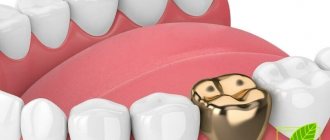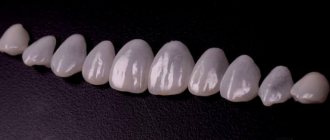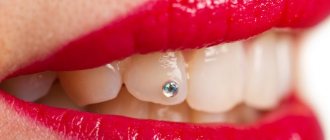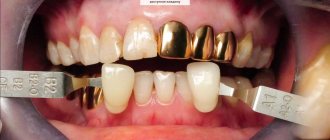Gold crowns on teeth have not lost their popularity (although it is, of course, not the same as before) even with the advent of new technologies in the field of prosthetics. Metal dental crowns remain the strongest, most durable, most ductile, and gold is still considered one of the best metals. Currently, orthopedists install ceramic structures, which wear out much faster than gold prostheses.
Gold crowns can now only be ordered from government dental clinics that are licensed to work with precious metals. It is quite difficult to obtain such permission. For this reason, dentists usually use alloys that also contain gold. Unlike past times, they now prefer to install gold crowns not on the front, but on the side teeth - incisors and molars, which are not very visible when smiling.
Features of crown manufacturing
But the manufacture of prostheses also requires certain conditions. The most important thing is the correct selection of the metal sample. Both the survival rate and the hardness of the substance depend on this indicator. Gold itself is a soft metal; if you use 999 grade in dentistry, it will not last long. Such a sample is easily deformed when bitten, and also quickly wears off. Its cost is also too expensive for the average person.
But if you take a low-grade alloy, it will also not work, since there are requirements for the alloy. If there is too much ligature, its ions gradually accumulate in the body and cause side effects. Local metallosis (accumulation of metal in the gums and adjacent teeth) may develop. And also certain alloys, for example, zinc and nickel, cause allergic reactions and blackening of neighboring areas. And some alloys can be carcinogenic.
Dental crowns are made to order in specialized dental clinics. Their cost will depend on the dollar exchange rate, which changes daily. This is explained by the fact that banks supply the precious metal to clinics. In particular, this service is offered by Sberbank of Russia.
Dental technicians shape the ingots and add the ligature. By the way, a sample can be found on some of them. The crown itself consists of a disk, as well as an upper part made of gold.
Since such a crown is completely unaesthetic, the cost of its installation is low. Dentistry is the only place where the cost of ceramics is higher than precious metals. There are several manufacturing methods:
- Stamping. These are the so-called fixes. Their advantage is cost. And the disadvantages are expressed in the inconvenience of use, curvature of the bite, loose fit to the gums, which is why inflammatory processes appear. Casting. It has an anatomically more correct shape and a tight fit. Although it is also not included in the concept of “esthetic dentistry”.
Gold assay and use of prostheses
The gold prosthesis must be sterile. Such things are made from 900 or 750 samples. 585 sample is very rare. Pawnshops also accept crowns and pay money for it. Only the item itself must be cleaned of plaque and dental materials. You can't get a lot of money for teeth.
Vacuum installations for applying gold coatings to dentures
In the documents, dental precious metal is indicated as “scrap gold in the form of crowns or dentures.” When selling, you should also take into account that gold-plated teeth coated with a layer of precious metal are not accepted by pawn shops.
If you are interested in the reverse process, which involves turning a prosthesis into a product, this involves refining and remelting the metal. Many people do cleaning at home. There are also common cases when there is a need to convert jewelry into a prosthesis. But it won’t be possible to do this legally, since clinics only work with material officially purchased from the bank.
Precious metals are now practically not used for their intended purpose in medicine. Modern techniques in dentistry have come a long way from primitive dentures. The placement of such implants is not justified and even dangerous. This method will also not allow gold miners to get very rich.
Hochuzoloto/prochee/zubnoe-zoloto. html"hochuzoloto
Use of gold in dentistry: price per gram and sample of dental crown.
Gold has been used in dentistry for a long time. In ancient times, gold teeth were a luxury that not everyone could afford. Gold emphasized the fact that its owner was financially wealthy. But even today, gold does not leave dental clinics as a material, even despite the fact that the price of dental gold per gram is quite high. In some cases, for example, due to medical indications, nothing else can be installed except for gold crowns.
Gold is considered one of the most reliable metals in dentistry for a reason. It has strength and durability, and in combination with sufficient ductility, it can compete even with modern ceramic denture designs.
But not all dental clinics can afford to install gold materials. This is mainly the prerogative of state-level dental clinics, because to work with valuable metals you need to obtain a license, and it is quite difficult to acquire.
Most clinics only work with alloys that may contain gold.
How to check whether it is gold or not?
12 ways to check gold for authenticity
- Look at the sample Factory products always have a standard stamp with a sample. ...
- Smell the product...
- Take a closer look at the joints...
- Apply a magnet...
- Check with vinegar...
- Drop some iodine...
- Draw with a lapis pencil...
- Look at the gold
in the sun and in the shade
Interesting materials:
My luggage went missing at the airport, what should I do? The gallery has disappeared on Android, what should I do? My package is missing, what should I do? Internet speed lost, what should I do? The riser in the apartment burst, what should I do? The deadline for entering into inheritance has passed, what should I do? The registration of a foreign citizen has expired, what should I do? Expired products in the store, what should I do? Expired products in the store, what to do? Expired goods, what should I do?
How are gold teeth made?
According to the manufacturing method, they can be:
Stamped ones, as you might guess from their name, are made from standardized stamps - blanks. Their sizes are adjusted immediately before fixation in the dentition with dental cement mortar. Cast versions of prostheses are created separately - they are cast from gold using wax casts made in advance. They do not require any adjustment during installation, as they are pre-provided with the required dimensions. Accordingly, they are more expensive, and to install them, you need to sharpen the tooth enamel more than when installing stamped crowns.
What type of gold is used and how much does one crown cost? The answer is simple: gold is used from the 850th to the 900th standard. But often prostheses do not consist of pure metal, but of its alloy with copper and silver, which allows the prosthesis to be stronger. On average, the price per gram is about two thousand rubles. The entire dental crown will cost from ten thousand rubles. To compare prices, you can give the following table:
How much does a metal-ceramic crown cost in Ukraine?
Many patients are interested in how much it costs to install a prosthesis; It is clear that the cost of a metal-ceramic crown (one piece) and prosthetic services depends on the complexity of installation in each individual case, and the average price of a dental crown (prosthesis) made of metal-ceramics for 1 (one) tooth in “Dentistry from A to Z” (Kyiv, ...
Interesting materials:
Where is the deeper metro in St. Petersburg or Kyiv? Where do black-headed gulls nest? Where do herring gulls nest? Where is horizontal and vertical? Where is the most delicious coffee in the world made? Where and from what is sugar obtained? Where and how was the papyrus stored? Where and how did Nekrasov spend his childhood? Where and how was the film Eternal Call filmed? Where and how did Astafiev study?
Conditions for installing a gold crown
There are cases when dentures need to be installed only from gold:
- if it is necessary to accurately restore the previous shape of the tooth; for the restoration of teeth involved in the chewing process, which bear a large load; with a strong bite or a habit of strong clenching or grinding of teeth. to strengthen teeth; or simply to improve the aesthetic appearance of the row.
Accordingly, there are contraindications for installing gold crowns. They cannot be installed if:
- the patient is under 16 years of age; there is a disease - chronic periodontitis; the patient is mentally ill; the patient is pregnant.
Indications
- Bruxism.
- The need to preserve the function of the incisors.
- Allergic reaction to non-gold materials.
- The need to reduce the risk of fracture after an endodontic procedure.
- Serious bite pathologies.
- The need to restore the anatomically correct shape of the tooth.
If for a number of reasons you want to insert gold teeth, sign up for a consultation with our specialists and find out in more detail about the cost, advantages and disadvantages of this type of crowns.
Preparation and installation of gold dental crowns
The process of preparing and manufacturing a prosthesis consists of the following stages:
First, the tooth is prepared. He needs to be healthy, without caries. If necessary, carry out treatment, replace the filling, if it is old, if the tooth was on a pin, restore it, etc. Next, before starting the procedure, the tooth needs to be anesthetized. Now it has to be ground down to place a crown on it. Grind on each side, adjusting to the thickness of the crown being installed. Giving it the required shape, additionally small ledges are made for better fastening. After grinding, plaster casts of both the upper and lower dentition are made. Using the plaster version, a wax model of the crown is created, and then a gold prototype is cast.
Procedure for installing a crown on a tooth
It doesn’t hurt to put a crown on a tooth at the MKS dental clinic in Kaliningrad: all manipulations are carried out under local anesthesia. The process includes the following steps:
- caries therapy, pulp removal, filling;
- production of gypsum unit variations;
- preparation of teeth (filing of tissue) and installation of temporary plastic crowns while the final structure is being manufactured using a plaster model;
- fitting process. Before placing a dental crown, the metal frame is measured and the veneer is applied;
- installation of permanent products subject to successful engraftment of temporary ones.
Installation of a gold crown
Making a crown takes some time, so the patient is given a temporary one for the time being. Its task is to relieve a person’s unpleasant feelings and give the treated tooth temporary protection from damage and destruction.
When the permanent crown is made, the following is installed:
The crown is tried on and, if necessary, additional adjustments are made to size. Immediately before fixation, it is fully checked how correctly the teeth meet the crown, whether it fits tightly, etc. And only now it is fixed with special dental cement.
Advantages and disadvantages of dental gold crowns
Gold dentures, like any other, have their positive and negative sides. The advantages include the following:
- gold in any quantity has a beneficial effect on teeth, microflora in the oral cavity and even on the entire body as a whole; this metal is absolutely inert to components of saliva or food; when the jaws meet, gold dentures do not cause any destructive effects on the teeth in the opposite row, which prevents wear of the “native” teeth; gold is not an allergen and therefore does not cause allergic reactions; gold crowns are very strong and durable. They can withstand any chewing load created by the jaw muscles and will never break or even be susceptible to chipping.
Among the disadvantages of gold prostheses, it is worth highlighting the following:
- As you know, gold is a soft metal. Although the crowns will be strong and reliable, they will still begin to wear out over time; gold is a precious metal and therefore, given its high value, installation may be prohibitively expensive for some people; Only the side teeth look aesthetically attractive; the gold front teeth are unlikely to look beautiful.
In the first days after installation, many patients will feel discomfort. After the end of the anesthesia effect, the sensitivity of the crowned tooth often increases and it begins to react - sometimes to touch, sometimes to cold or hot food. But it’s easy to relieve these symptoms: if you have sensitivity to temperature, special toothpastes are usually prescribed, and if you experience pain while eating, the denture is usually lowered a little lower.
Prodragmetally /rynok/kotirovki-i-tseny/ispolzovanie-v-stomatologii. html" prodragmetally
Forum of the Russian Dental Portal - Dentistry for Everyone! .
Metal-free ceramics for teeth
The use of new technologies for three-dimensional modeling and milling makes it possible to produce dentures from lightweight and durable materials - zirconium dioxide, E.max ceramics. Crowns made of metal-free ceramics, installed in, practically do not differ in appearance from a real tooth. In addition, they do not cause any allergic reactions.
Thanks to computer control of the denture production process, it is perfectly precisely placed in its place in the patient’s dentition. Such dental crowns, the prices in St. Petersburg for which are slightly higher than the cost of metal-ceramic products, can be used not only for prosthetics of lateral teeth in the dentition, but also for the restoration of front teeth.
Chieffa 08 Sep 2008
With enviable regularity, doctors hear the same question from patients: “Why, after installing crowns/inlays, does my head steadily pull down?” Or: “Which crowns are heavier: zirconium, metal-ceramic, cast, stamped? Because my teeth/gums are weak....”
The first five times doctors find it funny, then it’s no longer funny, and then they begin to think, “What if it’s really...?”
So, so that patients do not worry in vain, it will be useful for them to know: The average weight of one crown is 1.5 – 3 grams. The weight of the intra-root tab is 1.2 grams.
When chewing, the tooth experiences a load of 30 to 90 kg. So it doesn’t matter to the tooth whether a crown weighing 2 grams or 4 grams is on it!
For those who still feel that the weight acquired after prosthetics is pulling their head down, we can recommend having a haircut like this to move the center of gravity of the skull to its original place (longer at the back, shorter at the front).
Doc 14 Apr 2009
I had a MK bridge on my 4 upper incisors (6 years on temporary cement), they changed it to zirconium. It may be funny to doctors, but from personal feelings it seems that MK crowns are heavier. Not in the sense that it tilts the head forward. I don’t know how to explain correctly. Maybe it’s all a problem in the brain, or the bridge is of better quality, but it really has become easier
I think that if it stood for six years on temporary cement, then everything else in it was consistent with this fact. In addition, cast bridges have shrinkage, and as a result, if they are poorly seated, they can press and cause discomfort. Zirconium is milled and therefore does not give any shrinkage initially. And lastly, a good doctor will not make zirconium crowns into a six-unit bridge. Perhaps you now have them separately? In general, it's not about weight.
Tanata Apr 14, 2009
I think that if it stood for six years on temporary cement, then everything else in it was consistent with this fact. In addition, cast bridges have shrinkage, and as a result, if they are poorly seated, they can press and cause discomfort. Zirconium is milled and therefore does not give any shrinkage initially. And lastly, a good doctor will not make zirconium crowns into a six-unit bridge. Perhaps you now have them separately? In general, it's not about weight.
Not separately, unfortunately, I consulted 3 doctors, but the situation did not allow it. So maybe patients are actually not concerned about the weight of the crowns, but about these very sensations? But they can’t explain it properly. Doctors are driven to white heat with bad questions. And then similar topics arise.
Forum. stom /topic/3628-o-vese-koronok/» forum. stom
Gold crowns on teeth: how much do they weigh and how to clean?
Despite the active spread of various methods of prosthetics, metal prosthetics is the most popular. Therefore, in this article we will talk about gold crowns on teeth: how much do they weigh and how to clean them?
Note: They are performed like any other metal structures, but the result has higher final indicators.
In dentistry, products of different grades from 750 to 900 are used, depending on the type of prosthetics.
Types of crowns
- made of gold. They do not oxidize and do not cause inflammation and have some healing properties. The base is made of noble metal, coated with ceramics, thereby achieving the closest possible option to natural teeth. This base fits tightly to the gums and has a long service life - up to 15 years; made of an alloy of gold and platinum. Due to certain properties of the raw material, the crowns are quite thin and durable compared to the real composition. Due to such characteristics, an even tighter fit of the structure is achieved and a service life of up to 20 years is achieved.
Advantages and disadvantages
Dentures have a large number of positive properties:
- grinding of teeth is minimal due to the plasticity of the material and the density of installation; has a healing effect that prevents the development of an allergic reaction; metal corrosion does not form; Can be used on all elements, regardless of their location due to high strength; high aesthetics; their use does not cause tissue irritation; raw materials do not contain harmful substances; due to the equal expansion of gold and dentin, such crowns directly “get along”; there are practically no cases of breakdowns; the service life of this type of prosthesis is much higher than others; There is no abrasion of opposing teeth.
Important to know: In addition, the use of alloys or pure noble material is perfect for people who have general health problems: gastrointestinal, endocrine, allergic, etc.
In addition to a significant number of positive properties, this prosthetics has a number of disadvantages:
- Its biggest drawback is its high cost. This is due to the fact that the highest quality raw materials are used in prosthetics; it is possible for the base to show through, which can significantly damage the aesthetic result; increased wear of dentures.
Making crowns
Modern prosthetics with noble materials differs significantly from previously accepted ones. Today, ceramics are actively used to cover the base. The shine leaves only a light warm tint that shines through the ceramic mass.
There are two types of manufacturing of such structures:
Stamped, made from previously prepared cartridges. Their adjustment is carried out directly in the oral cavity shortly before final fixation. Cast structures are made according to the impression taken. Such designs do not require adjustment.
It should be taken into account that casting technology requires more grinding of the enamel.
Let's look at the manufacturing process itself:
- preliminary preparation (necessary treatment, tooth restoration, etc.); anesthesia; turning the enamel according to the required forms; taking impressions, and this procedure must be carried out with both jaws; making a preliminary model from plaster in the laboratory; According to the completed model, a design prototype is made; initial fitting with necessary adjustments; final consolidation.
Metal crowns: affordable prosthetics
Crowns of this type are made from alloys of gold, platinum, titanium, and steel. The presence of spraying is optional and is selected individually.
Stamped products are characterized by low cost, as well as lack of sufficient strength and anatomical fidelity. Because of this, irritation of soft tissues may occur, which will be injured by the edges of the crown. It is also possible for food to get and get stuck under the edges of the crown if it does not fit tightly. This can cause inflammation and discomfort. However, these problems will not occur if the crown is made by a master with extensive experience.
Metal crowns made using a one-piece casting method are characterized by increased wall strength. The material is formed in layers. This allows the denture to withstand more chewing load. Solid crowns require grinding for maximum ease of use.
Most often, metal crowns are used when a prosthesis is needed for chewing teeth located out of sight.










